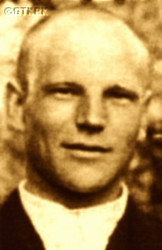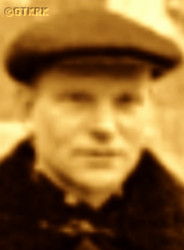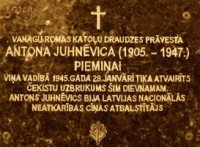Roman Catholic
St Sigismund parish
05-507 Słomczyn
85 Wiślana Str.
Konstancin deanery
Warsaw archdiocese, Poland
full list:
displayClick to display full list

searchClick to search full list by categories
wyświetlKliknij by wyświetlić pełną listę po polsku

szukajKliknij by przeszukać listę wg kategorii po polsku

Martyrology of the clergy — Poland
XX century (1914 – 1989)
personal data
religious status
Servant of God
surname
JUCHNIEWICZ
forename(s)
Anthony (pl. Antoni)
function
religious cleric
creed
Latin (Roman Catholic) Church RCmore on
en.wikipedia.org
[access: 2014.09.21]
congregation
Congregation of Marian Fathers of the Immaculate Conception of the Most Blessed Virgin Mary MICmore on
en.wikipedia.org
[access: 2013.05.19]
(i.e. Marians of the Immaculate Conception)
academic distinctions
Bachelor of Canon Law
date and place
of death
14.02.1947

Rigatoday: Riga city mun., Latvia
more on
en.wikipedia.org
[access: 2020.07.31]
details of death
During World War II started by German and Russian invasion of Poland in 09.1939 publicly opposed both German (from 05.1941) and Russian (from 05.1940 and after 1944) occupations of Latvia.
Hid men forcibly drafted in German and Russian army.
On 28.01.1945 together with his parishioners defended his church in Vanagi against NKVD attack, bringing partisans to his help.
Went into hiding and joined partisans under nom‐de‐guerre „Vientulis”.
On 28.08.1945 was elected chairman of Guards of Homeland Association (partisans), LTS (p) A, organization attempting to regain Latvia independence.
After arrest of 33 families from Varkava village by the Russians and incarceration in Dyneburg prison at the end of 1945 left partisan unit and return to his parish.
On 24.04.1946 arrested by the Russian KGB.
Brought to central prison in Riga and there after a mock trial murdered.
cause of death
murder
perpetrators
Russians
sites and events
Ribbentrop‐MolotovClick to display the description, Pius XI's encyclicalsClick to display the description
date and place
of birth
08.10.1905

(f. Bikawa municipality territory)today: Gaigalava pog., Rēzekne mun., Latvia
parents
🞲 ?, ? — 🕆 ?, ?

Hedwig
🞲 05.02.1877, Bērzpilstoday: Bērzpils pog., Balvi mun., Latvia
more on
lv.wikipedia.org
[access: 2025.02.11] — 🕆 ?, ?
presbyter (holy orders)
ordination
1932

positions held
1939 – 1945
parish priest — Vanagitoday: Vecvārkava pog., Preiļi mun., Latvia
more on
lv.wikipedia.org
[access: 2020.09.18] ⋄ St Anne RC parish
1938 – 1939
priest — Atašienetoday: Atašiene pog., Jēkabpils mun., Latvia
more on
en.wikipedia.org
[access: 2022.12.04] ⋄ Our Lady of Sorrows RC parish
1935 – 1938
priest — Kombuļitoday: Kombuļi pog., Krāslava mun., Latvia
more on
lv.wikipedia.org
[access: 2022.06.29] ⋄ Grace of God RC parish
priest — Daugavpilsform.: Dvinsk (1893‐1920)
today: Daugavpils urban mun., Latvia
more on
en.wikipedia.org
[access: 2020.07.31] ⋄ St Peter in Shackles RC parish
1932 – 1935
priest — Viļānitoday: Rēzekne mun., Latvia
more on
en.wikipedia.org
[access: 2021.05.20] ⋄ St Michael the Archangel RC parish
1930 – 1932
student — Lublintoday: Lublin city pov., Lublin voiv., Poland
more on
en.wikipedia.org
[access: 2021.08.20] ⋄ canon law, Catholic University of Lublin KUL [i.e. Catholic University of Lublin KUL (since 1928) / clandestine Catholic University of Lublin KUL (1939‐1944) / University of Lublin (1918‐1928)] — postgraduate specialised studies crowned with Canon Law Batchelor's degree
accession — Marians of the Immaculate Conception MIC
friar — Jesuits SI — shortly after joining resigned
student — Rigatoday: Riga city mun., Latvia
more on
en.wikipedia.org
[access: 2020.07.31] ⋄ philosophy and theology, Theological Seminary
author of the drama Lat. „Na vaineib as engeleits” (Eng. „Angel's fault”), Lublin 1932
sites and events
descriptions
Ribbentrop‐Molotov: Genocidal Russian‐German alliance pact between Russian leader Joseph Stalin and German leader Adolf Hitler signed on 23.08.1939 in Moscow by respective foreign ministers, Mr. Vyacheslav Molotov for Russia and Joachim von Ribbentrop for Germany. The pact sanctioned and was the direct cause of joint Russian and German invasion of Poland and the outbreak of the World War II in 09.1939. In a political sense, the pact was an attempt to restore the status quo ante before 1914, with one exception, namely the „commercial” exchange of the so‐called „Kingdom of Poland”, which in 1914 was part of the Russian Empire, fore Eastern Galicia (today's western Ukraine), in 1914 belonging to the Austro‐Hungarian Empire. Galicia, including Lviv, was to be taken over by the Russians, the „Kingdom of Poland” — under the name of the General Governorate — Germany. The resultant „war was one of the greatest calamities and dramas of humanity in history, for two atheistic and anti‐Christian ideologies — national and international socialism — rejected God and His fifth Decalogue commandment: Thou shall not kill!” (Abp Stanislav Gądecki, 01.09.2019). The decisions taken — backed up by the betrayal of the formal allies of Poland, France and Germany, which on 12.09.1939, at a joint conference in Abbeville, decided not to provide aid to attacked Poland and not to take military action against Germany (a clear breach of treaty obligations with Poland) — were on 28.09.1939 slightly altered and made more precise when a treaty on „German‐Russian boundaries and friendship” was agreed by the same murderous signatories. One of its findings was establishment of spheres of influence in Central and Eastern Europe and in consequence IV partition of Poland. In one of its secret annexes agreed, that: „the Signatories will not tolerate on its respective territories any Polish propaganda that affects the territory of the other Side. On their respective territories they will suppress all such propaganda and inform each other of the measures taken to accomplish it”. The agreements resulted in a series of meeting between two genocidal organization representing both sides — German Gestapo and Russian NKVD when coordination of efforts to exterminate Polish intelligentsia and Polish leading classes (in Germany called «Intelligenzaktion», in Russia took the form of Katyń massacres) where discussed. Resulted in deaths of hundreds of thousands of Polish intelligentsia, including thousands of priests presented here, and tens of millions of ordinary people,. The results of this Russian‐German pact lasted till 1989 and are still in evidence even today. (more on: en.wikipedia.orgClick to attempt to display webpage
[access: 2015.09.30])
Pius XI's encyclicals: Facing the creation of two totalitarian systems in Europe, which seemed to compete with each other, though there were more similarities than contradictions between them, Pope Pius XI issued in 03.1937 (within 5 days) two encyclicals. In the „Mit brennender Sorge” (Eng. „With Burning Concern”) published on 14.03.1938, condemned the national socialism prevailing in Germany. The Pope wrote: „Whoever, following the old Germanic‐pre‐Christian beliefs, puts various impersonal fate in the place of a personal God, denies the wisdom of God and Providence […], whoever exalts earthly values: race or nation, or state, or state system, representatives of state power or other fundamental values of human society, […] and makes them the highest standard of all values, including religious ones, and idolizes them, this one […] is far from true faith in God and from a worldview corresponding to such faith”. On 19.03.1937, published „Divini Redemptoris” (Eng. „Divine Redeemer”), in which criticized Russian communism, dialectical materialism and the class struggle theory. The Pope wrote: „Communism deprives man of freedom, and therefore the spiritual basis of all life norms. It deprives the human person of all his dignity and any moral support with which he could resist the onslaught of blind passions […] This is the new gospel that Bolshevik and godless communism preaches as a message of salvation and redemption of humanity”… Pius XI demanded that the established human law be subjected to the natural law of God , recommended the implementation of the ideal of a Christian state and society, and called on Catholics to resist. Two years later, National Socialist Germany and Communist Russia came together and started World War II. (more on: www.vatican.vaClick to attempt to display webpage
[access: 2023.05.28], www.vatican.vaClick to attempt to display webpage
[access: 2023.05.28])
sources
personal:
www.kresy.plClick to attempt to display webpage
[access: 2013.01.06], lv.wikipedia.orgClick to attempt to display webpage
[access: 2016.03.14], nekropole.infoClick to attempt to display webpage
[access: 2016.03.14]
bibliographical:
„Lexicon of Polish clergy repressed in USSR in 1939‐1988”, Roman Dzwonkowski, SAC, ed. Science Society KUL, 2003, Lublin
original images:
lv.wikipedia.orgClick to attempt to display webpage
[access: 2016.03.14], www.diena.lvClick to attempt to display webpage
[access: 2016.03.14], www.dekaini.lvClick to attempt to display webpage
[access: 2016.03.14]
LETTER to CUSTODIAN/ADMINISTRATOR
If you have an Email client on your communicator/computer — such as Mozilla Thunderbird, Windows Mail or Microsoft Outlook, described at WikipediaPatrz:
en.wikipedia.org, among others — try the link below, please:
LETTER to CUSTODIAN/ADMINISTRATORClick and try to call your own Email client
If however you do not run such a client or the above link is not active please send an email to the Custodian/Administrator using your account — in your customary email/correspondence engine — at the following address:

giving the following as the subject:
MARTYROLOGY: JUCHNIEWICZ Anthony
To return to the biography press below:
 Click to return to biography
Click to return to biography










